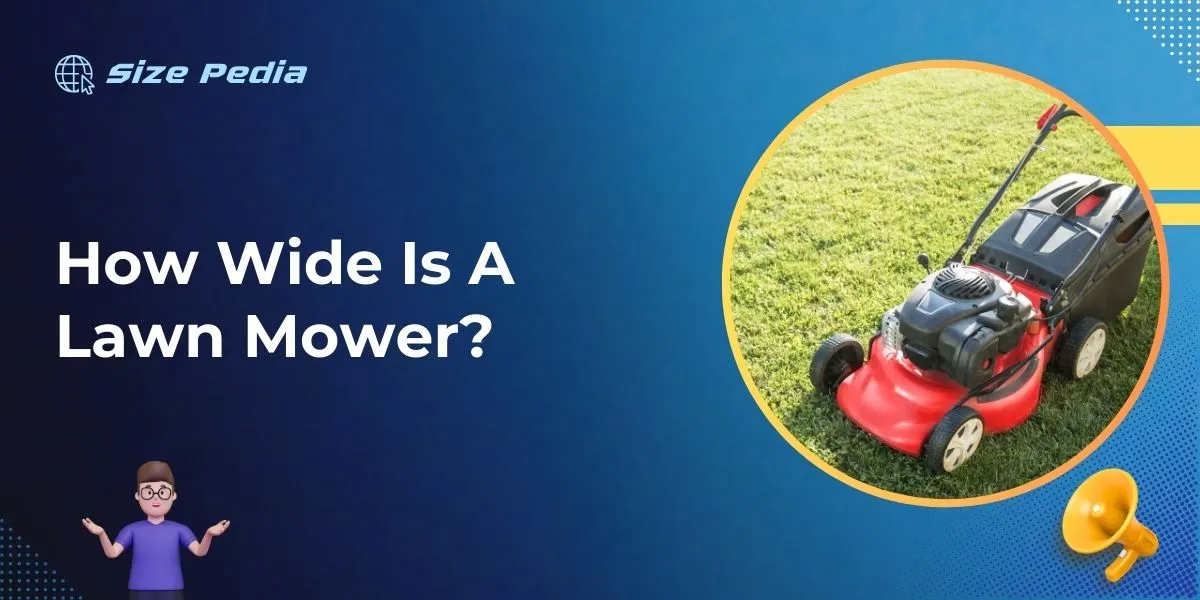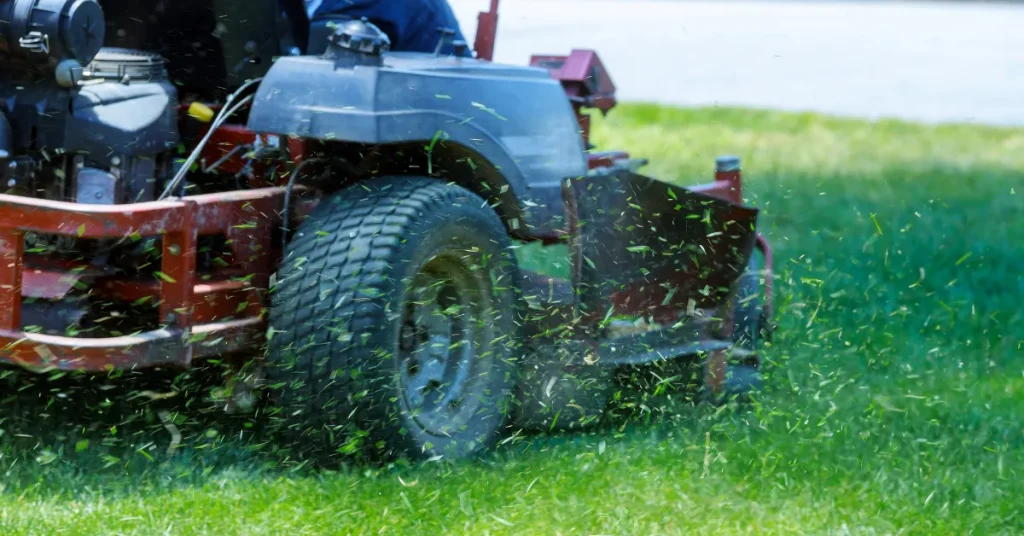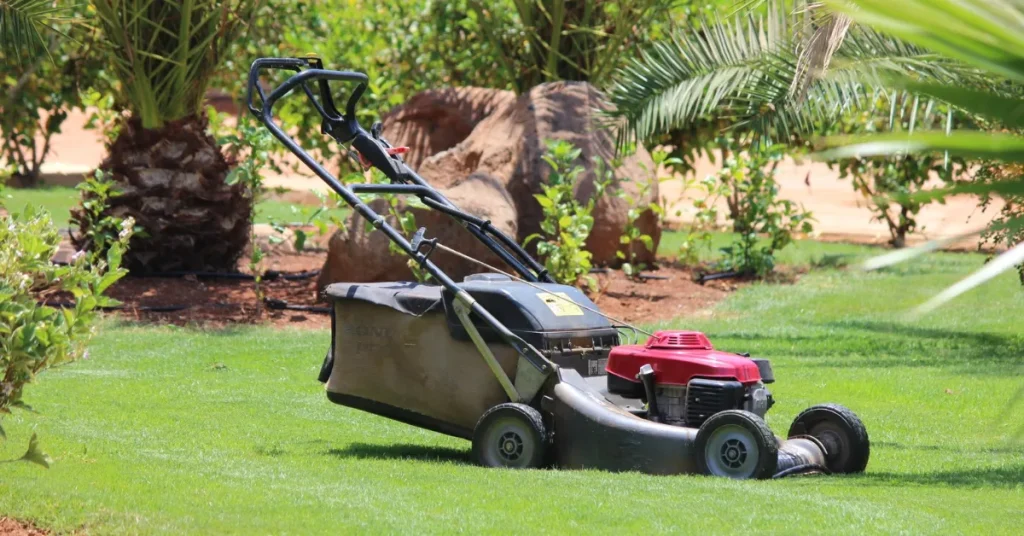The width of a standard lawn mower varies from 20 to 30 inches. Residential models typically fall within this range.
Selecting the right lawn mower for your yard involves considering the machine’s width for efficiency and convenience. A lawn mower’s width determines how much grass it cuts in one pass and directly impacts the time you spend mowing.
A wider model can speed up the process in expansive yards, while a narrower one might be preferred for maneuverability in smaller spaces or gardens with intricate landscaping.
The width also affects storage, as a broader mower requires more room when not in use. Durability, engine size, and additional features also play vital roles in your decision.
Ultimately, the best choice balances mowing width with the specific demands of your lawn. Remember to compare different sizes and read reviews to find a mower that suits your needs.

Assessing Lawn Mower Width
Your lawn mower’s width can define your mowing routine’s efficiency. Picking the right width is crucial.
It impacts how fast you can mow your lawn and how easily you can navigate through tight spaces. Let’s explore the factors that determine mower sizes and the average widths you can expect from different types of mowers.
Factors Influencing Mower Size
Several elements affect lawn mower width. These are key to understanding your needs:
- Lawn size: Larger lawns may require wider mowers.
- Storage space: Ensure the mower fits in your shed or garage.
- Obstacles: Gardens or play areas impact the ideal mower width.
- Transport: Consider if you need to move the mower between locations.
Average Width Ranges By Mower Type
Different mowers have varied widths. Here’s a quick guide:
| Mower Type | Average Width |
| Push Mowers | 16-22 inches |
| Riding Mowers | 30-60 inches |
| Zero Turn Mowers | 42-72 inches |
| Robotic Mowers | 7-29 inches |
All mowers are designed for specific lawn environments. Choose a mower width that complements your lawn’s size and complexity.
Types Of Lawn Mowers Explained
Understanding the types of lawn mowers is crucial before selecting the right one. Size and functionality differ across the varieties.
This guide will navigate through the common types, focusing on their widths. Lawn mowers range from small, compact models to larger, more powerful units. Each type serves a unique purpose for different lawn sizes and shapes.
Push Mowers: Compact And Maneuverable
Push mowers stand out for their simplicity and agility. Ideal for small to medium-sized yards, they provide an easy solution for grass cutting.
Their widths typically span from 16 to 22 inches. This makes navigating through tight spaces a breeze. Below are key traits of push mowers:
- Compact design: Fits in small storage spaces.
- Maneuverable: Eases navigation around obstacles.
- Eco-friendly options: Includes manual reel mowers.
Riding Mowers: Wide And Efficient
Riding mowers offer comfort and speed for larger lawns. Their deck sizes range broadly, starting at 30 inches and going up to 60 inches or more. With wider cutting paths, they reduce mowing time significantly. Attributes of riding mowers include:
- Efficiency: Covers large areas quickly.
- Comfort: Features a seat and various controls.
- Versatility: Accommodates attachments for various tasks.
Zero-turn Mowers: Wide And Agile
Zero-turn mowers combine the width of riding mowers with enhanced agility. They maneuver efficiently with a turning radius that is virtually zero. This precision allows for quick, neat lawn cutting. Their width usually measures between 42 and 61 inches. Characteristics include:
- Speed: Fast operation and job completion.
- Control: Exceptional maneuverability.
- Precision: Accurate trimming around edges and obstacles.
| Type | Width Range (inches) | Best for Lawn Size |
| Push Mowers | 16 – 22 | Small to Medium |
| Riding Mowers | 30 – 60+ | Large |
| Zero-Turn Mowers | 42 – 61+ | Large with Obstacles |
Maximizing Efficiency In Yard Care

Maximizing Efficiency in Yard Care means choosing the right tools for the job. A lawn mower’s width plays a crucial role in how quickly and effectively you can tend to your grass.
Understanding this can save time and energy, turning lawn care into a less daunting task. Knowing your mower’s width helps tailor your approach, ensuring your yard looks its best with minimal effort.
Matching Mower Width To Lawn Size
The width of your mower dictates how wide each swath of cut grass will be on every pass. Select the right width for your lawn size; it makes all the difference. Small yards might need a mower that’s around 20 inches wide.
Larger areas benefit from wider mowers, some reaching up to 60 inches. Use this straightforward guide:
| Lawn Size | Suggested Mower Width |
| Under 1/2 acre | 20-30 inches |
| 1/2 to 1 acre | 30-40 inches |
| Over 1 acre | 40-60 inches |
Mowing Patterns For Optimal Coverage
How you mow is as important as the mower width. Different patterns can lead to better grass health and appearance. Try these tips:
- Alternate your pattern each time you mow to prevent grass from leaning in one direction.
- Start with the perimeter first, then move inwards in straight lines for even coverage.
- For riding mowers, use the overlap technique, wherein each pass overlaps the previous one slightly to avoid missed strips.
- For push mowers, aim for a stripe effect by pushing in one direction and then the opposite on the return pass.
Utilizing these methods ensures full coverage of your lawn, reducing the time and effort needed in yard care.
Navigating Obstacles And Narrow Spaces
Navigating the twists and turns of a complex garden requires a lawn mower that’s just the right size.
With gardens dotted with flower beds, trees, and perhaps even a pond, mowing around such obstacles is a part of lawn care. The width of your mower plays a big role here.
Handling Tight Turns And Edges
Maneuvering through slim paths and around tight corners demands agility. A narrow cutting deck and responsive steering are key. For optimal control:
- Look for mowers with zero-turn capability.
- Slimmer mowers pass through narrow gaps with ease.
- Self-propelled models help with smooth transitions.
Ensuring your mower’s deck is no wider than your smallest gap is crucial. This avoids the need for frustrating maneuvers or resorting to hand trimming.
Choosing A Mower For Constricted Areas
When faced with a garden full of challenges, picking the right mower size makes all the difference. Tips for selection:
- Measure your tightest spot. Choose a mower that’s at least 2 inches narrower.
- Opt for a compact mower for greater flexibility.
- Electric mowers tend to have smaller decks.
Smaller lawn mowers can ensure every corner and curve are neatly trimmed, keeping your lawn pristine.
Maintenance And Storage Considerations
Maintaining and storing a lawn mower takes careful planning. Wide lawn mowers especially need enough room and proper care.
A well-maintained mower ensures your garden looks its best. Moreover, correct storage prolongs the life of your mower, no matter its size.
Storing Wide Lawn Mowers
Wide lawn mowers come with unique storage needs.
- Foldable Handles: Check if the mower has foldable handles to save space.
- Cover: Use covers to protect from dust and moisture.
- Vertical Storage: Some models allow upright storage to reduce footprint.
Create a dedicated spot in your garage or shed. Ensure the storage area is dry and away from extreme temperatures. Clean the mower before putting it away. This prevents rust and keeps the mower ready for its next use.
Long-term Care For Different Mower Sizes
Different sizes of lawn mowers need specific care approaches. Here’s what to keep in mind:
| Mower Size | Care Tips |
| Small | Easy to maintain. Often manual or electric. |
| Medium | Check components like batteries and cables regularly. |
| Wide | Clean cutting decks and replace blades as needed. |
No matter the mower size, always follow the manufacturer’s instructions. Perform regular checks on blades, oils, and filters.
Charge batteries for electric models and stabilize fuel for gas ones if not in use for long. Regular care avoids costly repairs and keeps your lawn mower running smoothly.
Choosing The Right Lawn Mower Width

Finding the perfect lawn mower requires understanding the width options.
Lawn mower widths can dramatically affect mowing efficiency and experience.
It’s essential to consider personal needs and the specific characteristics of your lawn.
Personal Needs And Lawn Characteristics
- Yard Size: Larger areas might benefit from wider mowers.
- Mowing Frequency: Regular mowers might choose comfort over size.
- Storage Space: Narrow mowers take up less room in sheds or garages.
Match the mower width to your yard’s layout. Think about trees, paths, and flower beds.
Tight spaces call for narrower mowers for maneuverability.
Pros And Cons Of Wide Vs. Narrow Mowers
| Wide Mowers | Narrow Mowers | |
| Pros | Quickly cover large areasLess time mowing | Easy to maneuverIdeal for small lawns |
| Cons | Harder to storeMay miss tight spots | Takes longer for large lawnsMore passes required |
- Consider a wide lawn mower if time saving ranks top on your list.
- For spaces with many obstacles, choose a narrower option.
- Balance the need for speed against the ease of navigation.
- Always consider storage constraints.
FAQs About How Wide Is A Lawn Mower
What Is A Good Width Lawn Mower?
A good width for a lawn mower typically ranges from 16 to 30 inches, depending on lawn size and storage space. Larger yards benefit from wider mowers to reduce mowing time.
What Is The Average Size Of A Riding Lawn Mower?
The average riding lawn mower has a deck size of 30 to 60 inches. These mowers are ideal for larger lawns of half an acre or more.
How Wide Is A 42 Inch Mower?
A 42-inch mower deck typically measures around 50 to 55 inches wide, factoring in the discharge chute.
How Do You Measure The Width Of A Lawn Mower?
To measure the width of a lawn mower, extend a tape measure across the widest part of the mower’s body, excluding the handles. Record the measurement from edge to edge for the mower’s width.
Conclusion
Wrapping up, the width of lawn mowers varies significantly. From compact 20-inch models for small yards to robust 60-inch machines for large estates, there’s a size for every need.
Remember, matching mower width to your lawn size optimizes mowing efficiency and lawn health.
Choose wisely for a perfectly manicured green space.
Resources:
1. http://www.aqmd.gov/home/programs/community/electric-lawn-and-garden-programs/electric-lawn-mower-rebate-program
